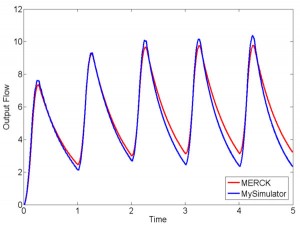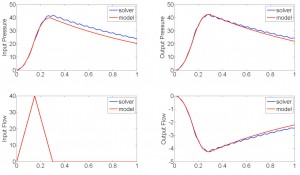Modeling and Simulation of Blood Flow in Arterial Networks
Understanding certain medical conditions requires understanding certain aspects of the blood flow in the arterial network. For instance, studying atherosclerosis requires capturing detailed flow inside an arterial segment. Such research requires developing accurate solvers for the detailed equations describing both the blood flow and the elastic behavior of the arteries. On the other hand, studying hypertension requires computing pressure and averaged flow over a larger arterial network. Such analysis requires developing compact computationally inexpensive models of complex segments of the arterial network. These models relate the pressure and average flow at the terminals of the arterial segments and must be easily interconnected to form complex and large arterial networks.
In this research we first developed a 2-D fluid-structure interaction solver to accurately simulate blood flow in arteries with bends and bifurcations. Such blood flow is mathematically modeled using the incompressible Navier-Stokes equations. The arterial wall is modeled using a linear elasticity model [1]. Our solver is based on an enhanced immersed boundary method (IBM) [2]. As a second step we have used state-of-the-art system identification techniques [3] to generate passive models for complex arterial segments such as large arteries, arterial bends, and bifurcations. We have validated our IBM solver results versus reference results obtained from MERCK Research Laboratories for a straight vessel of length 10cm and diameter 2cm. Our results for pressure, flow, and radius variations are within 3% of those obtained from MERCK. Furthermore, we have validated our model results by cascading different models and comparing the results of the resulting network to those predicted by the IBM solver. Our results for pressure and flow at the terminals of the models are within 10% of those obtained from the full simulator. In addition, by using the models we obtain more than 100,000 times reduction in the computational time.
- Figure 1: Output flow at the middle of a straight 10-cm artery as a function of time. Simulations performed using our immersed IBM code and compared to reference results obtained from MERCK.
- Figure 2: A 20-cm artery is constructed by cascading two models for a 10-cm artery. The model results are compared to those obtained by simulating the 20-cm artery using the IBM. Figure shows input/output flow and input/output pressure at the terminals of the 20-cm artery.
References
- A. Quarteroni, M. Tuveri, and A. Veneziani, “Computational vascular fluid dynamics: problems, models and methods,” Computing and Visualization in Science, vol. 2, no. 4, 2000, pp. 163-97. [↩]
- C. Peskin and D. McQueen, “A Three- Dimensional Computational Method for Blood Flow in the Heart I. Immersed Elastic Fibers in a Viscous Incompressible Fluid,” Journal of Computational Physics, vol. 81 , no. 2, 1989, pp. 372 – 405. [↩]
- B. Bond et. al., “Compact Modeling of Nonlinear Analog Circuits using System Identification via Semi-Definite Programming and Incremental Stability Certification,” to be published, IEEE Trans. on CAD of Integrated Circuits and Systems [↩]

